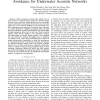Free Online Productivity Tools
i2Speak
i2Symbol
i2OCR
iTex2Img
iWeb2Print
iWeb2Shot
i2Type
iPdf2Split
iPdf2Merge
i2Bopomofo
i2Arabic
i2Style
i2Image
i2PDF
iLatex2Rtf
Sci2ools
INFOCOM
2007
IEEE
2007
IEEE
Aloha-Based MAC Protocols with Collision Avoidance for Underwater Acoustic Networks
— Unlike terrestrial networks that mainly rely on radio waves for communications, underwater networks utilize acoustic waves, which have comparatively lower loss and longer range in underwater environments. However, the use of acoustic waves pose a new research challenge in the networking area. While existing network schemes for terrestrial sensor networks are mainly designed for negligible propagation delay and high data rate, underwater acoustic communications are characterized by high propagation delay and low data rate. These terrestrial schemes, when directly applied to the underwater channel, will under-utilize its already limited capacity. We investigate how the underwater channel’s throughput may be enhanced via medium access control (MAC) techniques that consider its unique characteristics. Specifically, we study the performance of Aloha-based protocols in underwater networks, and propose two enhanced schemes, namely, Aloha with collision avoidance (Aloha-CA), and Aloha w...
| Added | 03 Jun 2010 |
| Updated | 03 Jun 2010 |
| Type | Conference |
| Year | 2007 |
| Where | INFOCOM |
| Authors | Nitthita Chirdchoo, Wee-Seng Soh, Kee Chaing Chua |
Comments (0)

